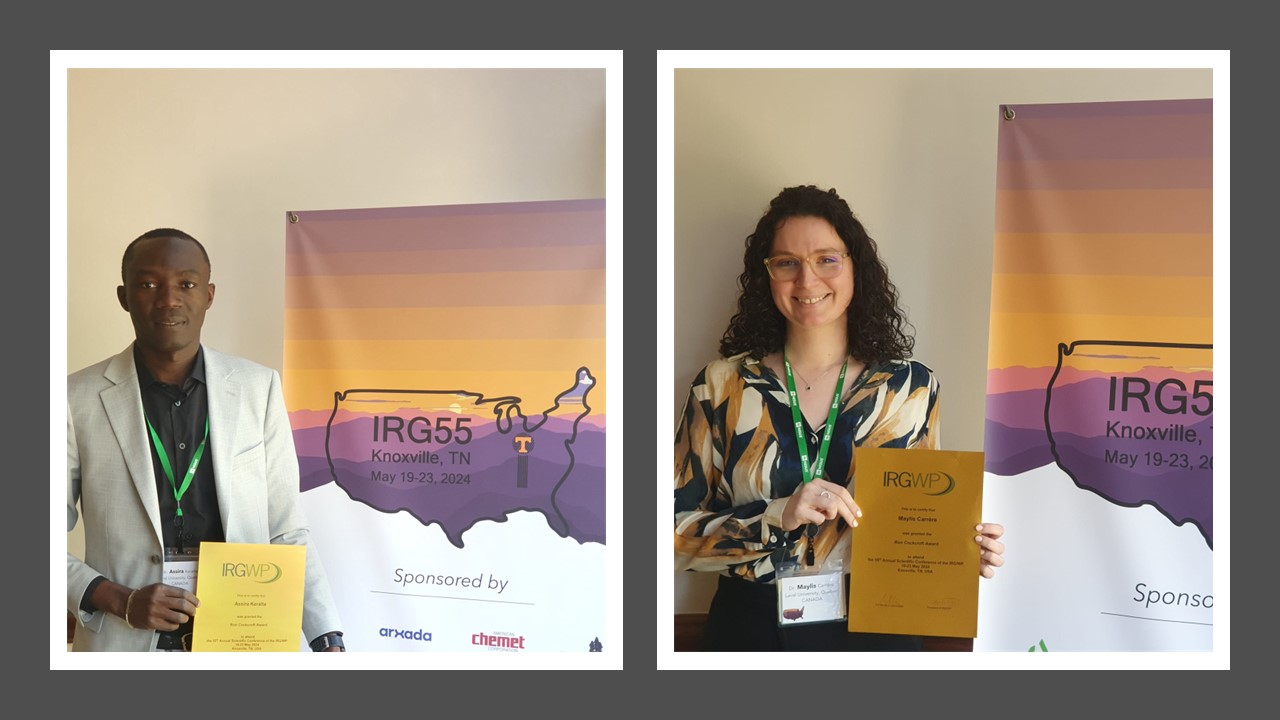Maylis Carrère and Assira Keralta participate in the 55th International Conference of the « International Research Group on Wood Protection (IRG/WP) »!
Maylis Carrère and Assira Keralta, PhD students in wood science and bio-based materials under the supervision of Véronic Landry and recipients of the Ron Cockcroft Awards (RCA) from the International Research Group on Wood Protection (IRG/WP), took part in the 55th IRG/WP International Conference, held from 19 to 23 May 2024 in Knoxville, TN, USA.
During the conference, Maylis gave an oral presentation on her work on « terpene-based latex synthesis for exterior wood protection ». Assira also shared her results on « the use of whey ultrafiltration permeate as a biosourced agent of wood protection », through an oral presentation.
Congratulations to you for this great achievement!
Thanks to the International Research Group on Wood Protection for recognising the commitment and talent of our young researchers through the RCA award and for giving them this wonderful experience.

From left to right: Assira Keralta and Maylis Carrère
Summary of Assira’s presentation
The ever-growing demand for sustainable materials has driven research toward innovative strategies in both the fields of material science and environmental management. Wood is a natural composite that is attracting more and more attention due to its high physical strength, great machinability, aesthetic appeal, and low price as a renewable and biodegradable resource. It has a long-standing history of utilization across various industries, particularly in construction and manufacturing. However, its low dimensional stability due to fluctuations in humidity and temperature has posed challenges to its widespread application. The resulting issues of deformation, cracking, and decay have prompted the exploration of effective wood modification methods that can enhance its dimensional stability and resistance to environmental factors to ensure a lasting value. Whey ultrafiltration (UF) permeate is a dairy by-product obtained during the purification of soluble proteins from cheese whey. It is composed of lactose (± 5% w/w), non-protein nitrogen (< 0.5% w/w), and minerals (< 0.5% w/w). Its production has been steadily increasing in recent years, but valorisation pathways are still very limited. Nevertheless, it represents a significant waste for the dairy industry, and requires special attention. Here, we demonstrate that malic acid and lactose of whey UF permeate can react both in sawdust and solid wood of trembling aspen. The polycondensation reaction in wood significantly reduces its water uptake ability and increases its dimensional stability by over 60%. This could open a new opportunity for the use of whey UF permeate as a wood protection agent.
Summary of Maylis’ presentation
Wood is a natural material with various intriguing physical and mechanical properties, including resistance to thermal changes and excellent insulating abilities. These qualities make it a suitable choice for use as a building material, particularly in the construction of exterior siding. However, wood can be susceptible to degradation due to weather conditions such as wind, rain, sun, and temperature variations, as well as the presence of micro-organisms. To preserve its properties and aesthetics, exterior wood surfaces are typically safeguarded with a coating. Water-based coatings are commonly prepared using emulsion polymerization technology. Historically, most latexes have been derived from petrochemical products, such as acrylate monomers. In an effort to reduce the environmental impact of these coatings, there is a growing interest in utilizing biobased raw materials. The primary objective of this project is to develop a coating for outdoor wood based on locally sourced biobased raw materials. Wood extractives will be functionalized with acrylate groups and then polymerized through emulsion polymerization to create biobased latexes. The glass transition temperature and particle size of latex particles were determined using differential scanning calorimetry (DSC) and dynamic light scattering, respectively. The integration of acrylated biobased monomers was confirmed using chromatography techniques such as Py-GC-MS. Subsequently, outdoor testing, including aging and fungi tests, was initiated.

